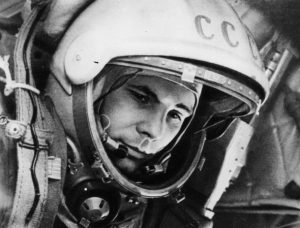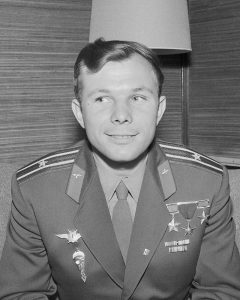By Wes O’Donnell
Managing Editor of In Military, InCyberDefense and In Space News.
This week in 1934, Soviet Air Force pilot and cosmonaut Yuri Gagarin was born in the village of Klushino near Gzhatsk, a town later renamed after him, in the Russian SSR.
The son of a carpenter, Gagarin was born on a collective farm in a region west of Moscow. He joined the Soviet Air Force in 1955 and graduated with honors from the Soviet Air Force Academy in 1957.
Get started on your Space Studies Degree at American Military University. |
Gagarin is best known as the first person to fly in space. His historic flight lasted only 108 minutes but it made him a cultural hero in the Soviet Union.
Because the Soviets did not want to risk losing such an important public figure, they were hesitant about allowing Gagarin to return to space. Ironically, on March 27, 1968, Gagarin was killed while test-piloting a MiG-15.
On NASA’s 1969 Apollo 11 mission, the first mission to put men on the moon, astronauts Neil Armstrong and Buzz Aldrin left behind a commemorative medallion bearing Gagarin’s name.
An Epic Flight

Using the call sign Kedr, (Russian: Кедр, Siberian pine or cedar,) Gagarin lifted off from the Baikonur Cosmodrome on board the Vostok 1 spacecraft on April 12, 1961.
A popular chronicle by Rex Hall of the Soviet space program, “The Rocket Men: Vostok and Voskhod, the First Soviet Manned Spaceflights” quotes the radio communication between the launch control room and Gagarin, including the following dialogue at the moment of rocket launch:
Korolev: Preliminary stage … intermediate… main… LIFT-OFF! We wish you a good flight. Everything’s all right.
Gagarin: Off we go! Goodbye, until [we meet] soon, dear friends.
Gagarin’s farewell to Korolev using the informal phrase Poyekhali! (Off we go!) later became a popular expression in the Eastern bloc that was used to refer to the beginning of the Space Age.
Interestingly, Gagarin had no control over his flight. Vostok’s reentry was controlled by a computer program sending radio commands to the space capsule. Although the controls were locked, a key had been placed in a sealed envelope in case an emergency situation made it necessary for Gagarin to take control.
As planned, Cosmonaut Gagarin ejected after reentry into Earth’s atmosphere at an altitude of 23,000 feet and landed by parachute.


Comments are closed.